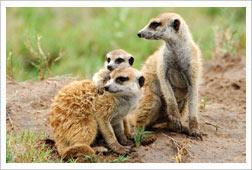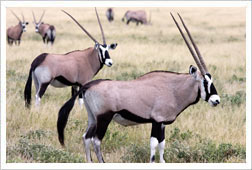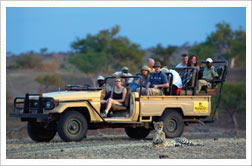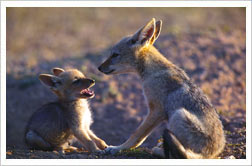
WELCOME TO BOTSWANA
Botswana is well known for having some of the best wilderness
and wildlife areas on the African continent. With a full 38
percent of its total land area devoted to national parks,
reserves and wildlife management areas – for the most part
unfenced, allowing animals to roam wild and free – travel
through many parts of the country has the feeling of moving
through an immense Nature wonderland.
Botswana is a rarity in our overpopulated, over-developed world.
Untamed and untameable, it is one of the last great refuges for
Nature’s magnificent pageantry of life.
Experience here the stunning beauty of the world’s largest
intact inland Delta – the Okavango;
the unimaginable vastness of the world’s second largest game
reserve – the Central
Kalahari Game Reserve; the isolation and other-worldliness
of the Makgadikgadi –
uninhabited pans the size of Portugal; and the astoundingly
prolific wildlife of the Chobe
National Park.
Botswana is the last stronghold for a number of endangered bird
and mammal species, including Wild Dog, Cheetah,
Brown Hyena, Cape Vulture, Wattled Crane, Kori
Bustard, and Pel’s Fishing Owl. This makes your safari
experience even more memorable, and at times you will feel
simply surrounded by wild animals.
The first – and most lasting impressions – will be of vast
expanses of uninhabited wilderness stretching from horizon to
horizon, the sensation of limitless space, astoundingly rich
wildlife and bird viewing, night skies littered with stars and
heavenly bodies of an unimaginable brilliance, and stunning
sunsets of unearthly beauty.
As well, with more and more cultural tourism options on offer,
you will be charmed by the people of Botswana, visiting their
villages and experiencing first-hand their rich cultural
heritage. But perhaps most of all, Botswana’s greatest gift is
its ability to put us in touch with our natural selves. It
offers that vital link so keenly felt by inhabitants of the
developed world, a pervasive void we feel but often cannot name
– our connectedness with Nature and the astonishing diversity of
plants and animals to be explored.
Location: Botswana is a land-locked country
situated in southern Africa. It borders South Africa, Namibia,
Zambia and Zimbabwe. Approximately two-thirds of the country
lies within the Tropics.
One of the most sought after wilderness destinations in the
world, the Okavango Delta gives entrance to the spectacle of
wild Africa such as dreams are made of – the heart-stopping
excitement of big game viewing, the supreme tranquility and
serenity of an untouched delta, and evocative scenes of
extraordinary natural beauty.
A journey to the Okavango Delta – deep into Africa’s untouched
interior – is like no other. Moving from wetland to dryland –
traversing the meandering palm and papyrus fringed waterways,
passing palm-fringed islands, and thick woodland, resplendent
with lush vegetation, and rich in wildlife – reveals the many
facets of this unique ecosystem, the largest intact inland delta
in the world.
The Okavango Delta is situated deep within the Kalahari Basin,
and is often referred to as the ‘jewel’ of the Kalahari.
Swollen with floodwaters from the summer rains, the Okavango
River travels from the Angolan highlands, crosses into Botswana
at Mohembo in the Caprivi, then later spills over the vast,
fan-shaped Delta. The timing of the floods is uncanny. Just as
the waters from Botswana’s summer rains disappear (April, May),
so the floodwaters begin their journey – 1300 kilometres of
which is through Kalahari sands – revitalising a vast and
remarkably diverse ecosystem of plant and animal life.
The water’s flow, distribution and drainage patterns are
continually changing, principally due to tectonic activity
underground. As an extension of Africa’s Great Rift Valley, the
Okavango is set within a geographi-cally unstable area of
faults, and regularly experiences land movements, tremors and
minor quakes. By the time the water reaches Maun, at the Delta’s
southern fringes, its volume is a fraction of what it was. As
little as two to three percent of the water reaches the
Thamalakane River in Maun, over 95 percent lost to evapo-transpiration.
But the flow doesn’t stop in Maun.
It may continue east to the Boteti River, to fill Lake Xau or
the Makgadikgadi
Pans, or drain west to Lake River to fill Lake Ngami.
The Kgalagadi landscape often appears as grassy plains dotted
with low shrubs, interspersed with trees or belts of trees,
which often stand on sandy ridges. Though a newcomer’s first
impression may be one of ‘sameness,’ there are subtle
topographical interruptions to the desert’s essentially flat
surface, including channels, fossil valleys, dune features and
pan depressions. Following a season of good rain, the desert is transformed,
covered with lush, green grasses, and flooded pans – a source of
rebirth and rejuvenation for both humans and animals. Many desert animals, including springbok, gemsbok,
eland, and even the Kalahari lion, are supremely adapted to its
semi-arid conditions, and can live without water, though they
will drink if water is available. Antelope derive their moisture by feeding at night and early
morning (when plants regain moisture), by eating succulent
plants (such as wild watermelons or wild cucumbers), and by
remaining inactive during the heat of the day to conserve body
moisture.
The Kgalagadi is essentially a basin into which sediments
have continually been deposited and covered with sand. It is a
region of great ecological, vegetative, geomorphological and
climatic diversity. At its northern reaches (gabon, Congo and
Zaire), the Kgalagadi lies in the humid tropics and is dominated
by parts of the Congo drainage system. At its core, in Botswana
and neighbouring countries (South Africa, Namibia, Zambia,
Zimbabwe and Angola), it is an arid to semi-arid region with
little surface water. The Kgalagadi is the largest continuous area of sand on
earth, touching nine African countries. With an approximate area
of 2.5 million sq kms, it extends through 30 degrees of latitude
and embraces several ecological zones. Within Botswana, the Kgalagadi embraces two unique
geographical regions: the Makgadikgadi
pans, which research reveals to have been a huge prehistoric
lake, suggesting that the Kgalagadi was at one time much wetter
than it now is, and the wetland delta system of the Okavango. Human occupation of the Kgalagadi goes as far back as the
Early Stone age. Its Middle Stone age inhabitants, the San,
developed survival strategies superbly adapted to – and in
harmony with - their environment, masterfully extracting food
resources from both the land and animals. Today, settlements,
including cattle farms, dot many areas of the desert. Five game reserves and national parks have been set aside in
Botswana’s vast share of the Kgalagadi. These are: Central
Kalahari game Reserve, Khutse
game Reserve, Makgadikgadi pans game Reserve, Nxai
Pan National Park, and the Kgalagadi
Transfrontier Park. All are remotely situated, separated by
vast distances; and for many visitors, the sensation of unending
space and pure isolation are the principle destinations. Spectacular landscapes, rich and varied wildlife, and a host
of historical, cultural and natural history attractions define
this unique and very striking corner of northeastern Botswana. Straddling the Shashe, Motloutse and Limpopo Rivers, which
serve as natural boundaries with Zimbabwe and South Africa, the
Northern Tuli Game Reserve (NTGR) comprises 71,000 hectares of
remarkably diverse habitat, including mophane bushland, riverine
woodland, and marshland, punctuated by towering sandstone
cliffs, basalt formations and unusually shaped kopjes – making
for truly breathtaking scenery. One of the largest privately owned game reserves in Southern
Africa and incorporating three major private concessions (Tuli
Safari Lodge, Nitani Private Game Reserve, and Mashatu Game
Reserve), the NTGR is home to 48 species of mammals and over 350
species of birds, with an estimated 20 000 animals residing in
the reserve.
The NTGR is adjacent to a larger area of eastern Botswana
called the Tuli Block. This is a ten kilometre wide strip of
land running approximately Northern Tuli Game Reserve 180
kilometres south to Martin’s Drift that holds a string of
commercial agricultural and game farms, several of which also
offer tourist facilities. Travellers keen for a more active safari experience will
delight in all there is on offer. You can hike the reserve, bike
the reserve, horse-ride the reserve, and even hot air balloon
the reserve! At Mashatu Game Reserve, guests can accompany
elephant or predator researchers, to gain first-hand insights
into the behaviour, feeding habits, territories, demography, and
social structure of these animals, as well as critical wildlife
conservation issues. A similar experience awaits guests at
Nitani – as they come to understand the complexities of a
long-term hyena research project.
Molema is a joint venture between three local villages:
Motlhabaneng, Lentswe le Moriti and Mathathane and two tour
operators: Tuli Safari Lodge and Talana Farms. Archaeological sites provide an important historical
perspective to the region. Iron Age sites demonstrate the
formidable skills in pottery, mining, and smelting of the Zhizo,
Leopard’s Kopje and Mapungubwe peoples, who practised
agriculture and animal husbandry in the area. Artifacts from the Mapungubwe Kingdom (1220-1290AD), a
precursor to the Great Zimbabwe civilisation, reveal the
sophistication of the technology and society of its people, and
their extensive trade networks. The NTGR will form the heart of the proposed Shashe/Limpopo
Trans- Frontier Conservation Area (TFCA), its signatories –
Botswana, Zimbabwe and South Africa – agreeing to cooperate to
conserve and manage shared natural resources. Rich in
biodiversity, the proposed TFCA will cover approximately 4,872
square kilometres and will be one of the largest wildlife
conservation areas in Southern Africa.
![]()
Botswana Tourism
Board
Fairground Office Park, Plot 50676
Gaborone, Botswana
Website:http://www.botswanatourism.co.bw/

Country Size: Botswana covers an area of 581
730 square kilometres – about the size of France or Kenya.
Topography: Most of the country is flat, with
some small hills in the eastern areas. Kalahari sands cover 84
percent of the surface area. With the exception of the northern
areas, most of Botswana is without perennial surface water.
Capital: Gaborone
Urban Centres: Francistown, Lobatse,
Selebi-Phikwe
Tourism Centres: Maun, Kasane
Government: Multi-party democracy
Head of State: His Excellency Lt. Gen. Seretse
Khama Ian Khama
Population: 1.85 million, with an average
annual growth rate of 2.4 % (2006 statistics)
National Language: Setswana
Official Language: English
Currency: Pula
Main Exports: Diamonds, copper nickel, beef,
soda ash, tourism
Major Crops: Maize, sorghum, millet
That the Okavango exists at all – deep within this thirstland –
seems remarkable. Shaped like a fan, the Delta is fed by the
Okavango River, the third largest in southern Africa. It has
been steadily developed over the millennia by millions of tonnes
of sand carried down the river from Angola. A
land of singular, often hidden, beauty, the Kgalagadi is
intensely alive with an astonishing diversity of plant and
animal life. It has broad variations in vegetation, supporting
several savanna types, namely grass, shrub and tree savanna.
A
land of singular, often hidden, beauty, the Kgalagadi is
intensely alive with an astonishing diversity of plant and
animal life. It has broad variations in vegetation, supporting
several savanna types, namely grass, shrub and tree savanna. Kalahari
lions appear to gain their moisture from the body fluids of
their prey. Other common Kgalagadi animal species include
wildebeest, zebra,
kudu, red hartebeest, duiker, steenbok, and the predators, lion, cheetah, leopard,
and both spotted and brown hyena.
Kalahari
lions appear to gain their moisture from the body fluids of
their prey. Other common Kgalagadi animal species include
wildebeest, zebra,
kudu, red hartebeest, duiker, steenbok, and the predators, lion, cheetah, leopard,
and both spotted and brown hyena.
Northern Tuli Game Reserve
 Most
naturally occurring wildlife species are present, includingelephant,
kudu, zebra,
impala, duiker, wildebeest, waterbuck, steenbok, and warthog.
Large herds of eland – often not seen elsewhere in Botswana –
are present, and these are indeed an awesome sight. All major
predators, including lion, leopard,
cheetah and hyena, are present, and the birdlife is prolific.
Most
naturally occurring wildlife species are present, includingelephant,
kudu, zebra,
impala, duiker, wildebeest, waterbuck, steenbok, and warthog.
Large herds of eland – often not seen elsewhere in Botswana –
are present, and these are indeed an awesome sight. All major
predators, including lion, leopard,
cheetah and hyena, are present, and the birdlife is prolific. Molema
Bush Camp, a community based tourism project managed and
operated by Tuli Safari Lodge, is an ideal way to take part in a
tourism concept that is rapidly gaining momentum in Africa.
Local communities become active partners in tourism projects,
from which they can more readily see clear-cut financial and
social benefits.
Molema
Bush Camp, a community based tourism project managed and
operated by Tuli Safari Lodge, is an ideal way to take part in a
tourism concept that is rapidly gaining momentum in Africa.
Local communities become active partners in tourism projects,
from which they can more readily see clear-cut financial and
social benefits.